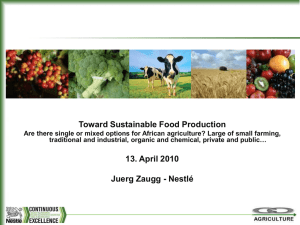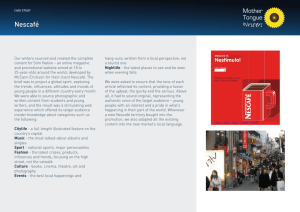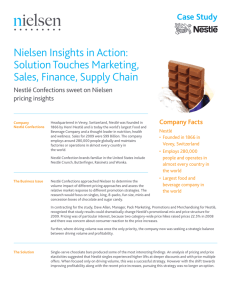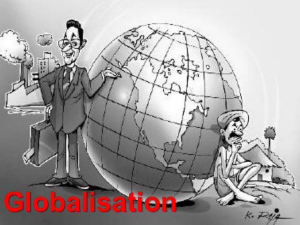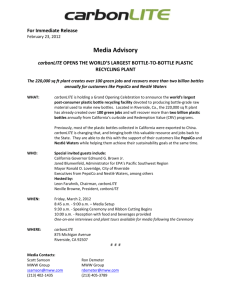Nestlé
advertisement
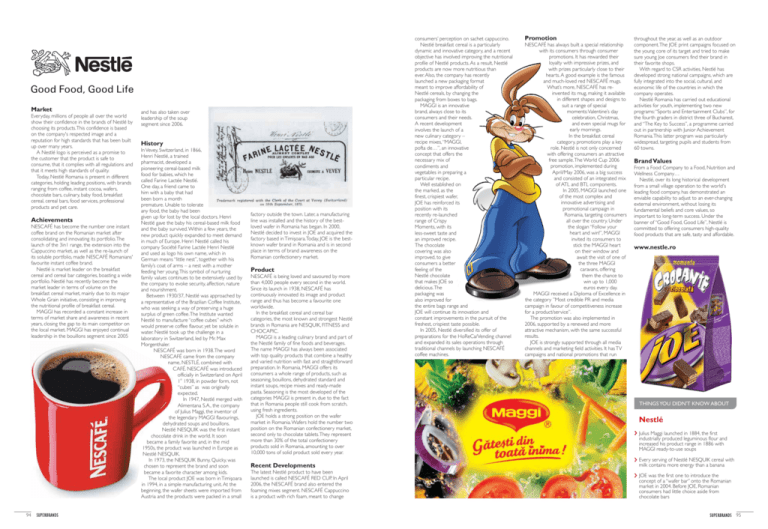
Market Everyday, millions of people all over the world show their confidence in the brands of Nestlé by choosing its products.This confidence is based on the company's respected image and a reputation for high standards that has been built up over many years. A Nestlé logo is perceived as a promise to the customer that the product is safe to consume, that it complies with all regulations and that it meets high standards of quality. Today, Nestlé Romania is present in different categories, holding leading positions, with brands ranging from coffee, instant cocoa, wafers, chocolate bars, culinary, baby food, breakfast cereal, cereal bars, food services, professional products and pet care. Achievements NESCAFÉ has become the number one instant coffee brand on the Romanian market after consolidating and innovating its portfolio.The launch of the 3in1 range, the extension into the Cappuccino market, as well as the re-launch of its soluble portfolio, made NESCAFÉ Romanians' favourite instant coffee brand. Nestlé is market leader on the breakfast cereal and cereal bar categories, boasting a wide portfolio. Nestlé has recently become the market leader in terms of volume on the breakfast cereal market, mainly due to its major Whole Grain initiative, consisting in improving the nutritional profile of breakfast cereal. MAGGI has recorded a constant increase in terms of market share and awareness in recent years, closing the gap to its main competitor on the local market. MAGGI has enjoyed continual leadership in the bouillons segment since 2005 94 and has also taken over leadership of the soup segment since 2006. History In Vevey, Switzerland, in 1866, Henri Nestlé, a trained pharmacist, developed a pioneering cereal-based milk food for babies, which he called Farine Lactée Nestlé. One day, a friend came to him with a baby that had been born a month premature. Unable to tolerate any food, the baby had been given up for lost by the local doctors. Henri Nestlé gave the baby his cereal-based milk food and the baby survived.Within a few years, the new product quickly expanded to meet demand in much of Europe. Henri Nestlé called his company Société Farine Lactée Henri Nestlé and used as logo his own name, which in German means “little nest”, together with his family’s coat of arms – a nest with a mother feeding her young.This symbol of nurturing family values continues to be extensively used by the company to evoke security, affection, nature and nourishment. Between 1930/37, Nestlé was approached by a representative of the Brazilian Coffee Institute, who was seeking a way of preserving a huge surplus of green coffee.The Institute wanted Nestlé to manufacture “coffee cubes” which would preserve coffee flavour, yet be soluble in water. Nestlé took up the challenge in a laboratory in Switzerland, led by Mr. Max Morgenthaler. NESCAFÉ was born in 1938.The word NESCAFÉ came from the company name, NESTLÉ, combined with CAFÉ. NESCAFÉ was introduced officially in Switzerland on April st 1 1938, in powder form, not “cubes” as was originally expected. In 1947, Nestlé merged with Alimentana S.A., the company of Julius Maggi, the inventor of the legendary MAGGI flavourings, dehydrated soups and bouillons. Nestlé NESQUIK was the first instant chocolate drink in the world. It soon became a family favorite and, in the mid 1950s, the product was launched in Europe as Nestlé NESQUIK. In 1973, the NESQUIK Bunny, Quicky, was chosen to represent the brand and soon became a favorite character among kids. The local product JOE was born in Timiºoara in 1994, in a simple manufacturing unit. At the beginning, the wafer sheets were imported from Austria and the products were packed in a small factory outside the town. Later, a manufacturing line was installed and the history of the bestloved wafer in Romania has began. In 2000, Nestlé decided to invest in JOE and acquired the factory based in Timiºoara.Today, JOE is the bestknown wafer brand in Romania and is in second place in terms of brand awareness on the Romanian confectionery market. Product NESCAFÉ is being loved and savoured by more than 4,000 people every second in the world. Since its launch in 1938, NESCAFÉ has continuously innovated its image and product range and thus has become a favourite one worldwide. In the breakfast cereal and cereal bar categories, the most known and strongest Nestlé brands in Romania are NESQUIK, FITNESS and CHOCAPIC. MAGGI is a leading culinary brand and part of the Nestlé family of fine foods and beverages. The name MAGGI has always been associated with top quality products that combine a healthy and varied nutrition with fast and straightforward preparation. In Romania, MAGGI offers its consumers a whole range of products, such as seasoning, bouillons, dehydrated standard and instant soups, recipe mixes and ready-made pasta. Seasoning is the most developed of the categories MAGGI is present in, due to the fact that in Romania people still cook from scratch, using fresh ingredients. JOE holds a strong position on the wafer market in Romania.Wafers hold the number two position on the Romanian confectionery market, second only to chocolate tablets.They represent more than 30% of the total confectionery products sold in Romania, amounting to over 10,000 tons of solid product sold every year. consumers’ perception on sachet cappuccino. Nestlé breakfast cereal is a particularly dynamic and innovative category, and a recent objective has involved improving the nutritional profile of Nestlé products. As a result, Nestlé products are now more nutritious than ever. Also, the company has recently launched a new packaging format meant to improve affordability of Nestlé cereals, by changing the packaging from boxes to bags. MAGGI is an innovative brand, always close to its consumers and their needs. A recent development involves the launch of a new culinary category – recipe mixes,“MAGGI, pofta de…”, an innovative concept that offers the necessary mix of condiments and vegetables in preparing a particular recipe. Well established on the marked, as the finest, crispiest wafer, JOE has reinforced its position with its recently re-launched range of Crispy Moments, with its less-sweet taste and an improved recipe. The chocolate covering was also improved, to give consumers a better feeling of the Nestlé chocolate that makes JOE so delicious.The packaging was also improved for the entire bags range and JOE will continue its innovation and constant improvements in the pursuit of the freshest, crispiest taste possible. In 2005, Nestlé diversified its offer of preparations for the HoReCa/Vending channel and expanded its sales operations through traditional channels by launching NESCAFÉ coffee machines. Promotion NESCAFÉ has always built a special relationship with its consumers through consumer promotions. It has rewarded their loyalty with impressive prizes, and with prizes particularly close to their hearts. A good example is the famous and much-loved red NESCAFÉ mugs. What’s more, NESCAFÉ has reinvented its mug, making it available in different shapes and designs to suit a range of special moments:Valentine’s day celebration, Christmas, and even special mugs for early mornings. In the breakfast cereal category, promotions play a key role. Nestlé is not only concerned with offering consumers an attractive free sample.The World Cup 2006 promotion, implemented during April/May 2006, was a big success and consisted of an integrated mix of ATL and BTL components. In 2005, MAGGI launched one of the most complex and innovative advertising and promotional campaign in Romania, targeting consumers all over the country. Under the slogan “Follow your heart and win!”, MAGGI invited its consumers to stick the MAGGI heart on their window and await the visit of one of the three MAGGI caravans, offering them the chance to win up to 1,000 euros every day. MAGGI received a Diploma of Excellence in the category ”Most credible PR and media campaign in favour of competitiveness increase for a product/service”. The promotion was also implemented in 2006, supported by a renewed and more attractive mechanism, with the same successful results. JOE is strongly supported through all media channels and marketing field activities. It has TV campaigns and national promotions that run throughout the year, as well as an outdoor component.The JOE print campaigns focused on the young core of its target and tried to make sure young Joe consumers find their brand in their favorite shops. With regard to CSR activities, Nestlé has developed strong national campaigns, which are fully integrated into the social, cultural, and economic life of the countries in which the company operates. Nestlé Romania has carried out educational activities for youth, implementing two new programs:“Sports and Entertainment Clubs”, for the fourth graders in district three of Bucharest, and “The Key to Success”, a programme carried out in partnership with Junior Achievement Romania.This latter program was particularly widespread, targeting pupils and students from 60 towns. Brand Values From a Food Company to a Food, Nutrition and Wellness Company… Nestlé, over its long historical development from a small village operation to the world's leading food company, has demonstrated an enviable capability to adjust to an ever-changing external environment, without losing its fundamental beliefs and core values, so important to long-term success. Under the banner of “Good Food, Good Life”, Nestlé is committed to offering consumers high-quality food products that are safe, tasty and affordable. www.nestle.ro THINGS YOU DIDN'T KNOW ABOUT Nestlé Julius Maggi launched in 1884, the first industrially produced leguminous flour and increased his product range in 1886 with MAGGI ready-to-use soups Recent Developments Every serving of Nestlé NESQUIK cereal with milk contains more energy than a banana The latest Nestlé product to have been launched is called NESCAFÉ RED CUP. In April 2006, the NESCAFÉ brand also entered the foaming mixes segment. NESCAFÉ Cappuccino is a product with rich foam, meant to change JOE was the first one to introduce the concept of a “wafer bar” onto the Romanian market in 2004. Before JOE, Romanian consumers had little choice aside from chocolate bars 95
